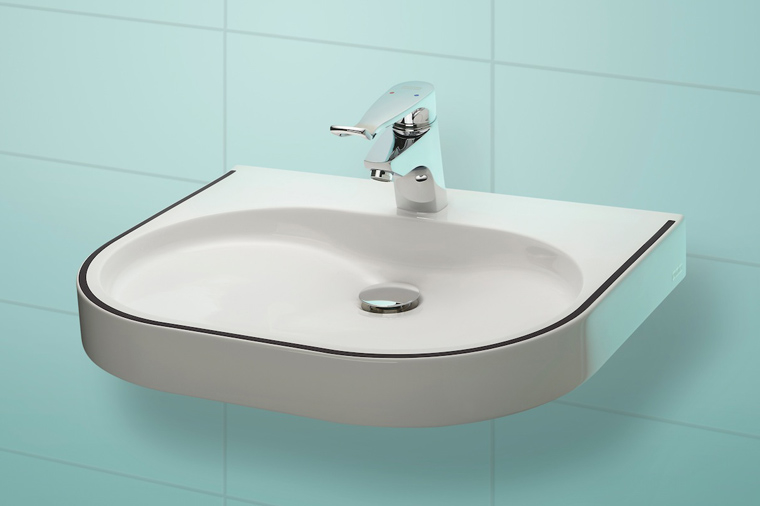Sustainability in bathrooms is not only characterised by durable products, but also by sustainable design and production methods which protect precious resources. Taste is dependent on culture, however, and differs from country to country. The Blue Responsibility manufacturers know how to combine global competence with local relevance to bring sustainable products on the market.
The German sanitary industry is internationally regarded as a pioneer for product design, quality and sustainability. But depending on country and cultural area, there are different colour preferences, deviating dimensions or completely different products for bathrooms. Adaptations due to certain national regulations and standards are everyday challenges for the Blue Responsibility manufacturers. One example for aesthetic sustainability is the globally popular Tara tap from Dornbracht which can already be regarded as a design classic today.
Design trends – different from country to country
Each country has different ideas on which designs are attractive. The brand manufacturers see the greatest deviations from Germany in Eastern Europe, in the Near and Middle East and in Africa. “We have found that purist and minimalist shapes are not always popular in those regions,” Inga Liesenjohann from Dornbracht explains. Russians, for example, prefer very classic colours and designs. Customers prefer elegant shapes and taps while fittings are dominated by light shades of gold and copper. Sabine Meissner from Burgbad sees an almost opulent taste in Russia, following baroque shapes or art nouveau elements.
But you do not have to go far afield to find different tastes in bathroom design. There are also differences between Germany and the United Kingdom. “In our experience, there is a much higher demand for gloss chrome flush plates in the UK,” Veit Szpak from Mepa says. In Northern Europe, it is mostly the surface colours that differ. Dark, contemporary shades are becoming increasingly popular in Scandinavia and the UK. Particularly simple tap designs can be found in France, but also the relaxed French “laissez faire” which is reflected in floral patterns and two-tone designs. To adapt to these national differences, the companies regularly carry out market surveys and exchange experiences with their sales partners in the respective countries. For the different requirements can only be met if the manufacturers study the preferred local designs in detail.
Sanitary solutions – with the required dimensions
The German sanitaryware manufacturers face a variety of challenges internationally not only in new buildings, but also for modernisation projects. In Russia, for example, about eighty per cent of people live in prefabricated buildings from Soviet times. Sustainable renovations are not easy, because the walls are lightweight construction and the rooms are very small. Despite millions of identical toilets and bathrooms, there were no thought-out and affordable renovation solutions on the Russian market until 2011. Geberit then developed a customised solution for prefabricated buildings at a reasonable price. “We have already been able to convince numerous Russians to have their bathrooms redesigned which can considerably and sustainably improve their quality of life,” Volker Röttger from Geberit explains. The focus here was not on luxurious bathrooms, but on a timeless, functional and cost-efficient solution.
In the USA, on the other hand, bathrooms are granted a lot of space. Even more than in Germany, the bathroom is an important room in the house and is increasingly turning into a private oasis of relaxation. Asia also has special requirements. “Bathtubs have to be much larger because Asian couples like to bathe together,” Marcus Möllers from Kaldewei explains.
Important: technical requirements and approvals
When products are sold outside Germany, other technical requirements as well as international test and quality labels also have to be taken into account, e.g. for water connections and lines. Northern Europe, for example, has special requirements for the water inlet into the cistern: It has to be a pipe within a pipe to prevent water damage. Cisterns also have to meet special standards in Russia. Switzerland has particularly strict sound insulation requirements according to the standard SIA 181. The list of special local regulations is virtually endless. “There are different standards for the height and depth of sinks, for example. This also applies to the area of accessible sanitary solutions where the Austrian ÖNORM B1600/16001 and the Swiss SIA 500 already deviate from the German DIN 18040. Products always have to be adapted locally,” Verena Töpfer-König from Franke Aquarotter explains. The volume regulator is an example for the fact that even the smallest components are subject to different standards. The requirements differ from country to country with regard to flow categories or water saving, driven by legal and voluntary campaigns. Additionally, the performance of volume regulators is influenced by the local conditions such as normal or low pressure, lime content and water temperature and has to be adapted accordingly. Everybody agrees on one thing internationally: “Customers worldwide expect a comfortable, full jet of water without splashes,” Bianca Federer from Neoperl says.
The German sanitaryware manufacturers always focus on the sustainability of products in the international market. “The fusion of global competence with local relevance allows the German sanitary industry to contribute to global sustainability – for bathrooms which not only function for decades but also remain attractive throughout life,” Wolfgang Burchard, spokesman of Blue Responsibility, summarises.
Learn more about "Sustainbale product design worldwide" on the manufacturers' websites www.burgbad.com, www.dornbracht.com, www.franke.com, www.geberit.de, www.kaldewei.de, www.mepa.de and www.neoperl.net
